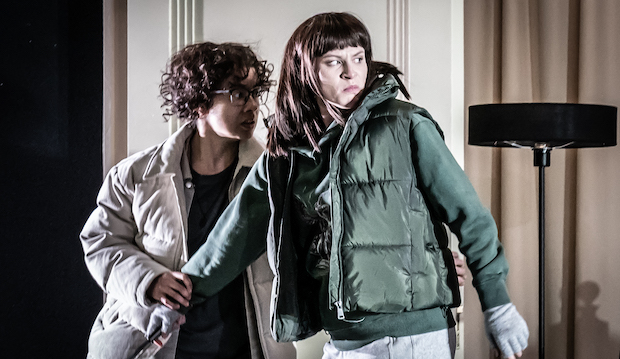Arminio, Royal Opera House review ★★★★★
Sarah Dufresne (left) as Tusnelda and Gabriele Kupšytė in the title role of Arminio. Photo: Marc Brenner
What a wonderful idea from the tongue-in-cheek Horrible Histories people to introduce young people to 'Orrible Opera at the BBC Proms this year. (There are two performances on Sat 22 July; booking opens Sat 13 May). The horrors – and thrills – they have in mind centre on the stories, but regular opera-goers can bring to mind a few horrible productions too.
At the Royal Opera House, Handel's Arminio, in a modern-day production has its pleasures. Here is a chance to hear a piece very rarely performed, with some lovely music, very beautifully sung by the next generation of great singers. In the pit, German-Brazilian conductor André Callegaro draws spirited playing from the Orchestra of the Early Opera Company. Oboe, cello and theorbo work stands out.

André Callegaro conducts Arminio. Photo: Marc Brenner
Of the singers, soprano Sarah Dufresne is particularly gifted with a voice of many colours and really musical phrasing. She has already made her mark at Covent Garden in the title role of Benjamin Britten's Rape of Lucretia, and is absolutely an artist to watch. Here she plays the loyal and courageous wife of Arminio, a Germanian prince raised in Rome who rebels against his country's imperial invaders. As Arminio, Lithuanian mezzo-soprano Gabriel Kupštyė is a dependable hero.
Roman bully Segeste is richly sung by Korean baritone Josef Jeongmeen Ahn. Handel's odd couple are Tusnelda's brother Sigismondo sung by soprano Isabelle Peters and his lover Ramise (Kamilla Dunstan). A male character singing higher than the female is always arresting, and this snug pair are quirky rebels with, in Ramise's case, a sting in the tail.

Isabelle Peters and Kamilla Dunstan as Sigismondo and Ramise. Photo: Marc Brenner
Updating the action to contemporary, undefined states reminds us that many peoples in our world are resisting invaders, but the production feels oddly detached from that reality and largely forces the singers upstage. Noemi Daboczi’s design for Mathilda du Tillieul McNicol’s production distances us from the action, which is sectioned off by opening and closing curtains of the hospital ward type.
Good lighting alone is enough to tell an audience which of two rooms to look at; skilled stage crew can create a new room in seconds. When you come away from the opera house, you want something other than the clatter of curtain rings sounding in your ears. Not exactly an ‘orrible opera, but not an ‘appy Arminio either.
Arminio is sung in Italian with English surtitles. Further performances are on 25, 28, 30 April; 3, 6 May.
At the Royal Opera House, Handel's Arminio, in a modern-day production has its pleasures. Here is a chance to hear a piece very rarely performed, with some lovely music, very beautifully sung by the next generation of great singers. In the pit, German-Brazilian conductor André Callegaro draws spirited playing from the Orchestra of the Early Opera Company. Oboe, cello and theorbo work stands out.

André Callegaro conducts Arminio. Photo: Marc Brenner
Of the singers, soprano Sarah Dufresne is particularly gifted with a voice of many colours and really musical phrasing. She has already made her mark at Covent Garden in the title role of Benjamin Britten's Rape of Lucretia, and is absolutely an artist to watch. Here she plays the loyal and courageous wife of Arminio, a Germanian prince raised in Rome who rebels against his country's imperial invaders. As Arminio, Lithuanian mezzo-soprano Gabriel Kupštyė is a dependable hero.
Roman bully Segeste is richly sung by Korean baritone Josef Jeongmeen Ahn. Handel's odd couple are Tusnelda's brother Sigismondo sung by soprano Isabelle Peters and his lover Ramise (Kamilla Dunstan). A male character singing higher than the female is always arresting, and this snug pair are quirky rebels with, in Ramise's case, a sting in the tail.

Isabelle Peters and Kamilla Dunstan as Sigismondo and Ramise. Photo: Marc Brenner
Updating the action to contemporary, undefined states reminds us that many peoples in our world are resisting invaders, but the production feels oddly detached from that reality and largely forces the singers upstage. Noemi Daboczi’s design for Mathilda du Tillieul McNicol’s production distances us from the action, which is sectioned off by opening and closing curtains of the hospital ward type.
Good lighting alone is enough to tell an audience which of two rooms to look at; skilled stage crew can create a new room in seconds. When you come away from the opera house, you want something other than the clatter of curtain rings sounding in your ears. Not exactly an ‘orrible opera, but not an ‘appy Arminio either.
Arminio is sung in Italian with English surtitles. Further performances are on 25, 28, 30 April; 3, 6 May.
TRY CULTURE WHISPER
Receive free tickets & insider tips to unlock the best of London — direct to your inbox
| What | Arminio, Royal Opera House review |
| Where | Royal Opera House, Bow Street, Covent Garden, London, WC2E 9DD | MAP |
| Nearest tube | Covent Garden (underground) |
| When |
20 Apr 23 – 06 May 23, Seven performances with one interval |
| Price | £returns only |
| Website | Click here for details and booking |